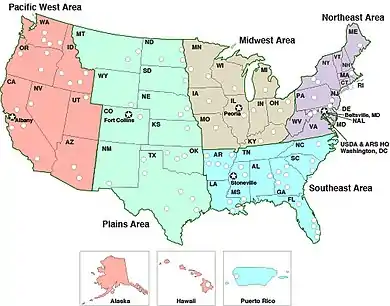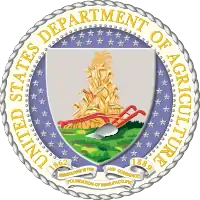Agricultural Research Service
The Agricultural Research Service (ARS) is the principal in-house research agency of the United States Department of Agriculture (USDA).[3] ARS is one of four agencies in USDA's Research, Education and Economics mission area. ARS is charged with extending the nation's scientific knowledge and solving agricultural problems through its four national program areas: nutrition, food safety and quality; animal production and protection; natural resources and sustainable agricultural systems; and crop production and protection. ARS research focuses on solving problems affecting Americans every day.[3] The ARS Headquarters is located in the Jamie L. Whitten Building on Independence Avenue in Washington, D.C. and the headquarters staff is located at the George Washington Carver Center (GWCC) in Beltsville, Maryland.[4] For 2018, its budget was $1.2 billion.[5]
 Former logo of the Agricultural Research Service | |
| Agency overview | |
|---|---|
| Formed | November 2, 1953 |
| Jurisdiction | United States federal government |
| Headquarters | Washington, D.C. |
| Employees | 7,379 employees (September 2017)[1] |
| Annual budget | $1.1 billion (FY14) |
| Agency executive |
|
| Parent agency | United States Department of Agriculture |
| Website | ars.usda.gov |
| Footnotes | |
| [2] | |
Mission
ARS conducts scientific research for the American public. Their main focus is on research to develop solutions to agricultural problems and provide information access and dissemination to:
- ensure high quality, safe food and other agricultural products,
- assess the nutritional needs of Americans,
- sustain a competitive agricultural economy.
- enhance the natural resource base and the environment, and
- provide economic opportunities to rural citizens, communities, and society as a whole.[3]
ARS research complements the work of state colleges and universities, agricultural experiment stations, other federal and state agencies, and the private sector. ARS research may often focus on regional issues that have national implications, and where there is a clear federal role. ARS also provides information on its research results to USDA action and regulatory agencies and to several other federal regulatory agencies, including the Food and Drug Administration and the United States Environmental Protection Agency.[6][3]
ARS disseminates much of its research results through scientific journals, technical publications, Agricultural Research magazine,[7] and other forums. Information is also distributed through ARS's National Agricultural Library (NAL).[3] ARS has more than 150 librarians and other information specialists who work at two NAL locations—the Abraham Lincoln Building in Beltsville, Maryland; and the DC Reference Center in Washington, D.C. NAL provides reference and information services, document delivery, interlibrary loan and interlibrary borrowing services to a variety of audiences.[8]
History
Prior to the inception of ARS, agricultural research was first conducted under the umbrella of the Agricultural Department in the U.S. Patent Office in 1839. It was created to collect statistics, distribute seeds and compile and distribute pertinent information. In 1862 the USDA was created and agricultural research was moved to its department. That same year, the department issued its first research bulletin on the sugar content of grape varietals and their suitability for wine. Six years later the USDA would begin its first research on animal diseases, specifically hog cholera, which was causing devastating losses at the time. In the early 1900s the USDA began analyzing food composition and the first studies of nutrition and the effects of cooking and processing foods were conducted. Finally, in 1953 the Agricultural Research Service was created to be the USDA's primary scientific research agency.[9][10]
Research centers

ARS supports more than 2,000 scientists and post docs working on approximately 690 research projects within 15 National Programs at more than 90 research locations.[3] The ARS is divided into 5 geographic areas: Midwest Area, Northeast Area, Pacific West Area, Plains Area, and Southeast Area.[11] ARS has five major regional research centers:
- Western Regional Research Center in Albany, California
- Center for Agricultural Resources Research in Fort Collins, Colorado
- Southern Regional Research Center in New Orleans, Louisiana
- National Center for Agricultural Utilization Research in Peoria, Illinois
- Eastern Regional Research Center in Wyndmoor, Pennsylvania
The research centers focus on innovation in agricultural practices, pest control, health, and nutrition among other things. Work at these facilities has given life to numerous products, processes, and technologies.[12][13][14][15]
ARS' Henry A. Wallace Beltsville Agricultural Research Center (BARC) in Beltsville, Maryland, is the world's largest agricultural research complex.[16] Other D.C. area locations include the United States National Agricultural Library and the United States National Arboretum.
ARS also has six major human nutrition research centers that focus on solving a wide spectrum of human nutrition questions by providing authoritative, peer-reviewed, science-based evidence.[17] The centers are located in Arkansas, Maryland, Texas, North Dakota, Massachusetts (the Human Nutrition Research Center on Aging), and California. ARS scientists at these centers study the role of food and dietary components in human health from conception to advanced age.[17]
The ARS also offers the Culture Collection, which is the largest public collection of microorganisms in the world, containing approximately 93,000 strains of bacteria and fungi. The ARS Culture Collection is housed at the National Center for Agricultural Utilization Research (NCAUR)[18] ARS operates the U.S. Horticultural Research Laboratory in Fort Pierce, Florida,[19] and the U.S. National Poultry Research Center in Athens, Georgia.[20] Other notable ARS facilities include Northern Great Basin Experimental Range in Oregon, and formerly the Plum Island Animal Disease Center off Long Island.
Research impacts
From the very beginning the Department of Agriculture and in turn the Agricultural Research Service has been focused on improving not only the farming industry but also the quality of food and the health of Americans. In 1985, technology to produce lactose-free milk, yogurt, and ice cream was developed through the Agricultural Research Service.[21] The grape breeding program, which began in 1923, developed seedless grapes.[22] The ARS Citrus and Subtropical Products Laboratory in Winter Haven, Florida, actively works to improve the taste of orange juice concentrate.[23]
The Agricultural Research Service had a Toxoplasma gondii (T. gondii) research program, which experimented on cats infected with the parasite, from 1982 until 2018. Through their research, the prevalence of T. gondii parasite has been reduced by 50% in the U.S. As of September 2018, the USDA has discontinued the use of cats in their research.[24][25]
More recently, the ARS has focused research on genetics and plant and animal DNA. Their research has developed pest-resistant corn, faster growing plants and fish, and a focus on plant and animal genome research and mapping. Outside of scientific research, the ARS has worked to release databases on food components in order to assist consumers with making informed decisions about food choices.[3][9]
See also
- Title 7 of the Code of Federal Regulations
- Agricultural Resource Management Survey
- Germplasm Resources Information Network
- Human Nutrition Research Center on Aging
- National Clonal Germplasm Repository
- National Agricultural Center and Hall of Fame
- U.S. Horticultural Research Laboratory
- National Interagency Confederation for Biological Research
References
- "Data, Analysis & Documentation:Raw Datasets". U.S. Office of Personnel Management. Retrieved 13 April 2018.
- "Agricultural Research Service". US Department of Agriculture.
- "About ARS : USDA ARS". www.ars.usda.gov. Retrieved 2018-04-13.
- "Headquarters Information: USDA ARS". US Department of Agriculture, Agricultural Research Service. Retrieved 2018-04-13.
- "Advocates celebrate funding bump for USDA-funded research". Science. AAAS. 2018-03-23. doi:10.1126/science.aat6839. Retrieved 2018-04-13.
- "Business : USDA ARS". www.ars.usda.gov. Retrieved 2018-04-13.
- "USDA ARS Online Magazine". agresearchmag.ars.usda.gov. Retrieved 2018-04-13.
- "About | National Agricultural Library | USDA". www.nal.usda.gov. Archived from the original on 2018-04-13. Retrieved 2018-04-13.
- "AllGov –Departments". www.allgov.com. Retrieved 2019-04-17.
- "comp : USDA ARS". www.ars.usda.gov. Retrieved 2019-04-17.
- "Find A Location : USDA ARS". www.ars.usda.gov. Retrieved 2018-04-13.
- "Eastern Regional Research Center : USDA ARS". www.ars.usda.gov. Retrieved 2018-04-13.
- "Regional Biomass Research Centers : USDA ARS". www.ars.usda.gov. Retrieved 2018-04-13.
- "USDA ARS Online Magazine Southern Regional Research Center, New Orleans, Louisiana". agresearchmag.ars.usda.gov. Retrieved 2018-04-13.
- "Children's Nutrition Research Center". Baylor College of Medicine. Retrieved 2018-04-13.
- "Beltsville Agricultural Research Center: USDA ARS Online Magazine Vol. 49, No. 10". agresearchmag.ars.usda.gov. Retrieved 2018-04-13.
- "Human Nutrition Research : USDA ARS". www.ars.usda.gov. Retrieved 2018-04-13.
- "NRRL culture collection". Archived from the original on 2015-02-05. Retrieved 2012-02-12.
- "U.S. Horticultural Research Laboratory : USDA ARS". www.ars.usda.gov. Retrieved 2018-04-13.
- "U.S. National Poultry Research Center : USDA ARS". www.ars.usda.gov. Retrieved 2018-04-13.
- Porch, Kaitlyn (2018-04-12). "Lactose-Free Milk, Low-Fat Cheese, and More Dairy Breakthroughs". www.federallabs.org. Retrieved 2018-10-26.
- Porch, Kaitlyn (2018-04-12). "Grapes! Our Never-Ending Crush". www.federallabs.org. Retrieved 2018-10-26.
- Porch, Kaitlyn (2018-03-16). "ARS Makes Condensed Orange Juice Taste More Like Fresh". www.federallabs.org. Retrieved 2018-10-26.
- "After thousands of cats died in experiments, USDA says it will stop controversial research program". USA TODAY. Retrieved 4 April 2019.
- "USDA is turning lab cats into cannibals by forcing them to eat feline meat, watchdog says". Washington Post. Retrieved 4 April 2019.
The organization alleges that the lab cats, which the U.S. Department of Agriculture houses at a facility in Beltsville, Md., were fed tongues, brains and hearts of cats purchased in at a meat market in China. Dogs purchased from shelters in Colombia and Brazil were killed, the report claims; then their brains, tongues and hearts were fed to the research cats. The goal was to study the parasite Toxoplasma gondii, which causes toxoplasmosis, a flu-like disease that can infect humans for weeks or months. ... Goodman called the practice “kitten cannibalism.”
Sources
- "Agricultural Research Service". Archived from the original on October 14, 2004. Retrieved 7 October 2005.
- "Image gallery". Agricultural Research Service. Archived from the original on 2005-10-06. Retrieved 7 October 2005. – An online catalog from the Agricultural Research Service Information Staff.
- "Western Regional Research Center". Archived from the original on 1 September 2009. Retrieved 1 September 2009.
- "Southern Regional Research Center". Archived from the original on 26 August 2009. Retrieved 1 September 2009.
- "National Center for Agricultural Utilization Research". Archived from the original on 31 August 2009. Retrieved 1 September 2009.
- "Eastern Regional Research Center". Archived from the original on 3 September 2009. Retrieved 1 September 2009.
- "ARS Human Nutrition Research". Archived from the original on 2 September 2009. Retrieved 1 September 2009.
- "National Agricultural Library". Archived from the original on 16 November 2008. Retrieved 19 November 2008.
External links
| Wikimedia Commons has media related to USDA Agricultural Research Service. |
